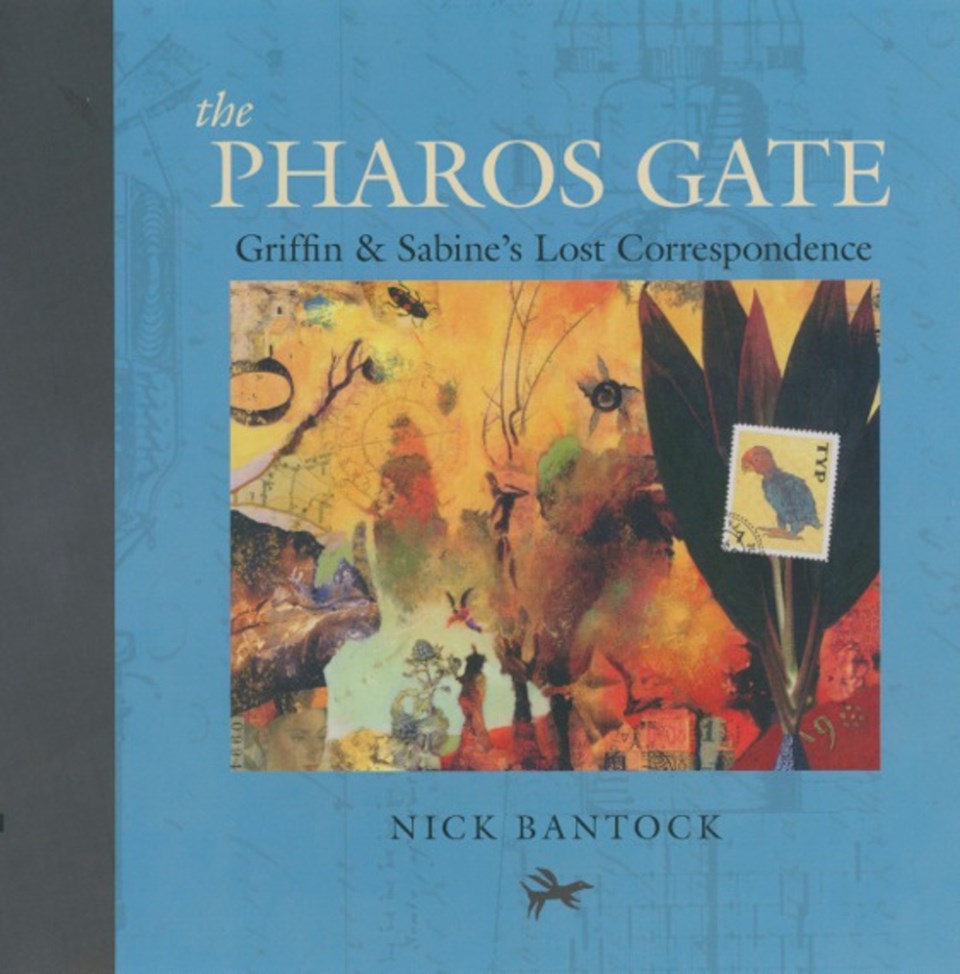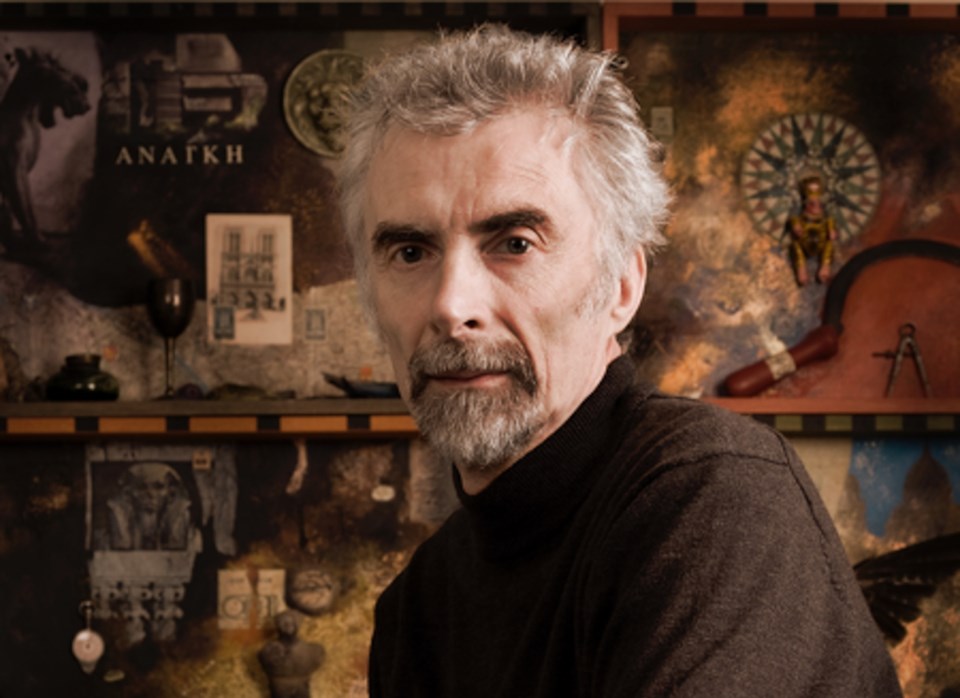Twenty-five years ago, a San Francisco publisher spotted an unusual book idea in illustrator Nick Bantock’s bag.
That book was Griffin and Sabine: An Extraordinary Correspondence – a concept the Bowen Island resident and English expat had been working on, where the main characters send letters across the ocean to each other, slowly developing their postcard-crossed love, while setting the plot of a fantasy thriller in motion.
Bantock had never written a book before, and yet his epistolary novel, told through a collection of drawings, collages, letters and postcards you could pull out of delicate, hand-stuffed envelopes within the book, was a revelation, landing the subsequent trilogy on the New York Times best-sellers list for 100 weeks, sparking a stack of film and television scripts, and ultimately selling more than three million copies.
I first encountered the series on my parents’ mantle. I didn’t understand them as a child. In fact, the unusual images scared me. Yet, I eventually came back to them – finally able to make sense of the odd, fragile picture books – and they now sit on my coffee table, ready to confound a new generation of romantics.
This year, much to the satisfaction of longtime readers and reviewers, Bantock released a seventh book in the series. I caught up with the amiable Brit by phone at his home in Victoria, BC, last week to talk about The Pharos Gate: Griffin & Sabine’s Lost Correspondence, and his upcoming reading at the Whistler Writers Festival.
I grew up flipping through your books and wondering what exactly these things were. I didn’t understand them, but now they’re prominently on display in my house.
[Laughs] I’m absolutely delighted to hear that. It’s funny – because they’ve been around for 25 years. It’s almost like we’ve gone through two complete generations of people.

Have you noticed a new generation coming on to them?
The new one helped do that – Pharos Gate, which came out earlier this year. That really did bring in a whole new group of people. But it’s surprising the number of people like you describe, where either their parents pass them on to them, or they just kind of stumbled on them in their parents’ library. I love it.
But the thing that makes me most happy is it shows that what I initially intended to do, certainly in terms of the imagery, was to make sure it didn’t date. And looking back it doesn’t, it has that timelessness that’s really gratifying.
When you were writing Pharos Gate, did you keep that in mind – that you’d be introducing this series to new people? Did you write it in a way that it could stand alone by itself?
You always have to do that. There’s always going to be pressure from the publisher to do that, from their perspective. But you’ve also got to balance that out. The last thing that you want is your long-term readers to be wading through what they already know. As if there wasn’t enough juggling, with trying to tell a story with postcards and letters, which is very minimal space compared to a fully-fledged novel. So yes, it had to stand on its own, but you have to be so, so careful that you’re not laying it out in simplistic regurgitation.
Pharos Gate falls between book three and four. How did you decided what part of the timeline to fit it into?
That became obvious, because there were two trilogies. [...] And I guess I, as much as anyone, wanted to know, ‘Well, what did happen at the end of the third book?’ As an author the best way to find out what happens to characters is to just let them speak.
And I’ve always been a believer in the fact that my job as an artist or a writer is to, not so much determine what’s going to happen or where something is going to go, but make myself available to see how it comes out.
Have you ever come across the Spanish term duende? It means the spirit of the Earth that passes through you, and just kind of comes out in the passion of your creativity. It’s pretty dramatic [laughs]. But it’s kind of what you do. You make yourself into sort of like, a pipe, or a culvert, and you’ve hopefully learned a fair degree of skills, and then you just see what comes out of you. It’s not automatic writing, but it’s kind of more like a Gestalt dialogue.
You mentioned that with the letters and the format of the book, you have less room to work with than a traditional novel. What parameters did you place around a single book while still telling the story you want to tell?
Well, in the case of Griffin and Sabine, I’m trying to tell many different layers. On the one level there’s the straightforward love story, and then of course the mystery, the whole esoteric undertone, an alchemical journey. There’s pretty much five layers. But you’ve also, in each postcard, in each letter, got to make it sort of semi-matter-of-fact, as though this is what people would actually, on some level, write to each other.
So it means you have to pick your works really carefully. You can take more time over each piece, each card, but you have to get this sort of exactness of running the five layers at the same time. So in a way it becomes a bit more like poetry in the selectivity of the words, but you don’t really have the option of making it poetic because it’s got to be day to day.

And, you’ve probably been asked this many times, but where did you get the initial idea to write a book like this? Were they based on something in your actual life?
The two main characters are clearly an internal dialogue between two parts of myself. You know, the sort of more cautious, careful, precise, exacting. And then the sort of looser, more exotic, in the broader sense of the word.
But I got the idea 25 years ago. I was living on Bowen Island, and I went to the local post office and someone else was getting their mail, and I was getting junk mail, and I was envious. And so I thought about writing to myself, and then I thought, no, I can’t do that. And then I started to think, what would perfect mail be?
Being an artist, because at that point I was 40 years old and I had never written anything – I was a painter – my ideal mail would have imagery. That’s where the idea of postcards came from. But if you’re going to have a dense dialogue you have to have letters. And anyway, opening letters, there’s something really sexy about that. So I conceived the idea pretty much walking up the hill and I put it together as a piece of self-indulgence, really. I never remotely imagined that it would actually ever be published, let alone be insanely successful.
How did it get published?
I created this dummy [mock-up] and was down in San Francisco seeing Chronicle Books showing them some other stuff – I worked in book covers, which is how I knew the publishing world. And I decided I wanted to do books of my own, and I had a bunch of ideas I was showing Chronicle, but I wasn’t going to show them the Griffin and Sabine dummy, because I thought it was, you know, too off the wall.
The editor I was seeing saw it in my bag and asked to look at at. And then a week later they phoned me up saying, ‘We want to do the book.’ And I said, ‘Wow, that’s amazing, who’s going to write it?’ And they said, ‘Well, you are.’ It took them about a week to convince me.
And then the original [September] print run was 10,000, but by that Christmas they had sold over a million.
Why do you think the books became so popular in the ‘90s?
I think it was a number of things. There had to be a novelty factor. Nobody had really done a book like that before, so the innate voyeurism of being able to read someone else’s letters was obviously a very powerful aspect of that.
And the fact that it was a love story, but also containing a number of different levels, meant that different people could appreciate it for different things. [...]
The publishers felt that even the original print run was a gamble because everyone said there wasn’t really an audience for this sort of thing out there. Yet, as it turns out, there were millions of people who, that’s exactly what they wanted.
And what section will you be reading from at the Writers Festival Cabaret on Oct. 14?
I’m going to be reading Griffin and somebody else is going to be reading Sabine.
It will be a seven- or eight-minute piece, with music, and I’m going to take a little bit from each of the [first] four books.
The Whistler Writers Festival runs Oct. 13-16 at venues around Whistler. Tickets and info at WhistlerWritersFest.com.


